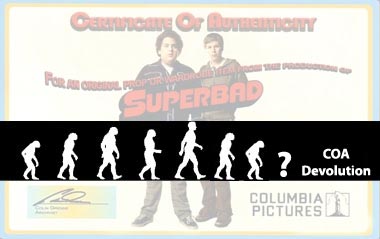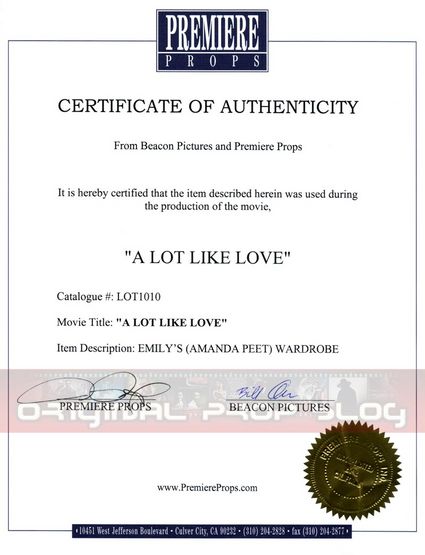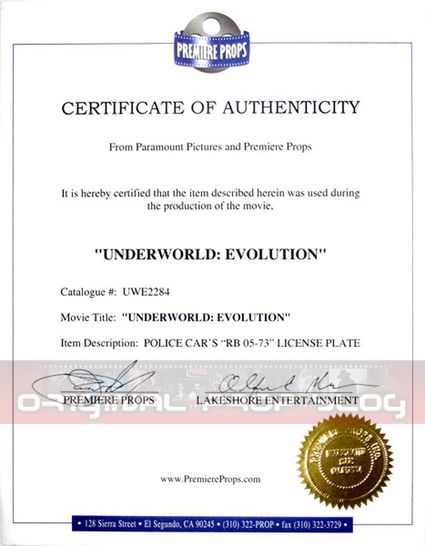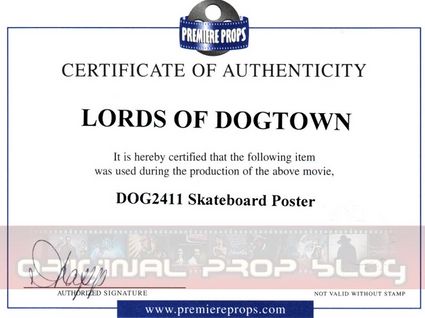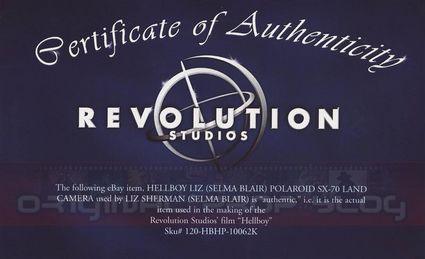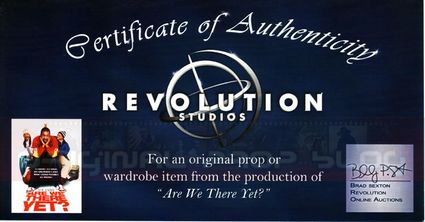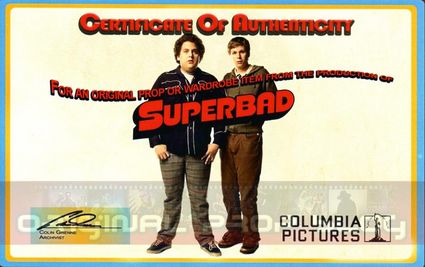Over the past several years, the Certificates of Authenticity (COAs) issued by two of the biggest “studio resellers” – Premiere Props and Hollywood Vault – have evolved. Unfortunately, the changes made have been to the detriment of provenance and is a significant missed opportunity given that these companies are in the position of releasing props and wardrobe into the marketplace that are sourced direct from the studios in a fully authorized capacity (making the pieces both authentic and with clear title).
I thought it would be informative to compare and contrast COAs issued by Premiere Props and Hollywood Vault to see exactly what changes have been made over the years, and the current state of certification and provenance offered by these two dealers.
Premiere Props
Here is an example of an earlier style Premiere Props COA:
High Resolution Archive: Premiere Props Sample COA #1
So what does this COA include?
- The Premiere Props Logo.
- The document is “from” both Premiere Props (the dealer) and (in this case Beacon Pictures) the studio.
- Contact Information for Premiere Props (web address, street address, phone and fax).
- A custom Premiere Props Seal (sticker).
- The original signature of an unidentified Premiere Props representative.
- The original signature of an unidentified studio representative.
- The movie title.
- A unique catalogue number assigned to the item.
- An item description.
The description/certification cites:
It is hereby certified that the item described herein was used during the production of the movie
I won’t go into the details of what is not included (such as a date of certification), but merely compare and contrast the COAs issued in order to learn what has changed over time.
This second sample includes the same basic information – only the logo and address/phone has changed:
High Resolution Archive: Premiere Props Sample COA #2
This third example appears to be the latest style employed by Premiere Props:
High Resolution Archive: Premiere Props Sample COA #3
With this style of COA, there are a number of changes compared with the earlier style:
- Dimensionally, the newer document is half the size of the old style.
- The COA is no longer “from” both the dealer and the studio – there is no citation of the studio anywhere on the document.
- The contact address and phone number is no longer printed on the document – only the website.
- The custom Premiere Props Seal (sticker) has been replaced by an imprinted stamp.
- The original signature of the unidentified Premiere Props representative remains, but there is no longer an accompanying original signature from a studio representative.
- The movie title and unique catalogue number still remain, as does the description (limited to title of the item).
- The description/certification remains.
The most significant and material difference between the two styles of documents is the complete absence of any reference to the studio, as well as it’s documented authorization (in the form of an original signature from a designated representative).
Hollywood Vault
Here is an example of an earlier style Hollywood Vault COA:
High Resolution Archive: Hollywood Vault Sample COA #1
So what does this COA include (also taking into account the Premiere Props examples)?
- No Hollywood Vault logo.
- The document is “from” the studio-only (in this case Revolution Studios) with no mention of the dealer/reseller (Hollywood Vault).
- No contact Information for Hollywood Vault (no web address, street address, phone and fax).
- No custom Hollywood Vault Seal, Stamp, or unique marking.
- No original signature of a Hollywood Vault representative.
- No original signature of a studio representative.
- The movie title.
- A unique SKU number assigned to the item.
- An item description.
The description/certification cites:
The following eBay item… is “authentic” i.e. it is the actual item used in the making of the… film…
I won’t go into the details of what is not included (such as a date of certification), but merely compare and contrast the COAs issued in order to learn what has changed over time, also considering the Premiere Props examples above.
This second sample is a more recent version of the same style COA, with some differences:
High Resolution Archive: Hollywood Vault Sample COA #2
Comparing only with the similar style Hollywood Vault COA above, these are the differences:
- This version includes a copy of (not an original) signature of presumably someone in the employ of the studio, also including his full name.
- This item does not include a SKU number.
- This item does not include any description of the item to which it is assigned and certifies as “original”.
The description/certification cites:
For an original prop or wardrobe item from the production of…
This is another more recent example of a Hollywood Vault COA, from a different studio (Columbia Pictures):
High Resolution Archive: Hollywood Vault Sample COA #3
This example does not differ in any material way from the second example above.
I have collected a number of other sample COAs, but again, there is no material difference between them.
The State of the Studio COA Today: Premiere Props and Hollywood Vault
Compared with other makes of studio COA in the marketplace (a topic for a future article), the Premiere Props and Hollywood Vault COAs leave a lot to be desired, in my opinion.
On the positive side, the Premiere Props COAs do include an original signature from someone within the company, the name of the prop, a unique identifying number, and identification of the company that issued it.
Things that are missing that are, in my opinion, inexcusable, are:
- Date of certification
- The name of the studio
- A photo of the item
- A better description of the item
Those four elements are available by virtue of the eBay auction from which the items are offered for sale, so including them as part of the COA would require very little effort, but offer the customers/owners of such pieces a much better record of provenance.
With regard to the Hollywood Vault COAs, in my candid opinion, they are on their own of nearly no value beyond the original buyer/owner.
They have become so completely generic, that they are in my opinion worthless without some effort on the part of the buyer to generate their own supplemental records – such as printing/electronically archiving the eBay auction from which it was acquired, keeping the purchase receipt that accompanies the item, etc.
In my opinion, both of these companies – which are two of the leaders among “studio resellers” just by virtue of the volume of their business – are really squandering the opportunity of offering authentic props directly from the studios. There is a very real ability to create a meaningful document that affirms the authenticity of each prop beyond the original buyer, but both are missing the mark with the current incarnation of their COAs.
Note: Special thanks to the collectors who provided scans of sample COAs.
Jason De Bord
Further Reading:
Original Prop Provenance & Authenticity, Part I
Instruments of Authenticity & The Chain of Provenance
Work in Progress: The Ultimate Original Prop COA, Part I
Work in Progress: The Ultimate Original Prop COA, Part II
“Off The Shelf” and “Found” Props & Wardrobe
Challenging The Hobby: The COA & The Guarantee

